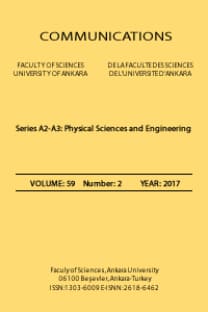3D VISUALIZATION APPROACH TO GPR DATA
Ground Penetrating Radar (GPR), GPR Data, Underground Structure, Anomalies, Profile, Trace, Sampling Value, Preprocessing, Interpolation, 3D Visualization
___
Arkedani, M.R., Neyt, X., Benedetto, D.,Slob, E.,Wesemael, B., Bogaert, P., Craeye, C., Lambot, S., 2014. Soil moisture variability effect on GPR data. 15th International Conference on Ground Penetrating Radar, Brussels, Belgium, p. 214-217.Conroy, J.P. and Radzeviciu, S.J. 2003. Compact MATLAB code for displaying 3D GPR data with translucence. Computers & Geosciences 29, 679–681.
Conyers, L.B. 2004. Ground-Penetrating Radar for Archaeology. AltaMira Press, Lanham
Dojack, L. 2012. Ground Penetrating Radar Theory, Data Collection, Processing and Interpretation: A Guide for Archaeologists, 7-9.
Giannopoulos, A., 2005. Modelling ground penetrating radar by GprMax. Construction and Building Materials 19, 755–762.
Goodman, D., Piro, S., Nishimura, Y., Schneider, K., Hongo, H., Higashi, N., Steinberg, J., Damiata, B., 2009. GPR archaeometry, In: Jol, H.M. (Ed.), Ground Penetrating Radar: Theory and Applications. Elsevier, Amsterdam, pp. 479-508.
Intyas, I., Suksmono, A.B., Munir, A. 2016. Image Quality Improvement for GPR Acquisition Using Interpolation Method. In: The 22nd Asia-Pacific Conference on Communications, Yogyakarta, Indonesia.
Kadioglu, S. and Ulugergerlic E.U. 2012. Imaging karstic cavities in transparent 3D volume of the GPR data set in Akkopru dam, Mugla, Turkey. Nondestructive Testing and Evaluation, 27(3), 263–271.
Maeland, E., 1988. On the comparison of interpolation methods. IEEE Transactions on Medical İmaging. 7, 213-217.
Nuzzo, L., Leucci, G., Negri, S., Carrozzo, M.T. and Quarta,T. 2002. Application of 3D visualization techniques in the analysis of GPR data for archaeology. Annals Of Geophysıcs, 45(2), 231-337.
Ozkan, M. and Samet, R., 2017. “Interpolation Techniques to Recover the Incomplete GPR Data”. In: The 16th International Conference Geoinformatics, Kiev, Ukraine.
Samet, R. and Özkan, M. 2016. Incomplete Data Production Techniques in GPR Research and Applications. In: The 15th International Conference Geoinformatics, Kiev, Ukraine.
Samet, R., Çelik, E., Tural, S., Şengönül, E., Özkan, M., E., Damcı, “Determining the optimal profile interval by using interpolation techniques in GPR applications”, J.Appl. Geophysics, 2017.
Sun, W., Xu, Q., Zhang, H., Yao, Z. 2012. Research on Detection and Visualization of Underground Pipelines. In: The 2nd International Conference on Remote Sensing, Environment and Transportation Engineering (RSETE), Nanjing, Jiangsu, China.
Zhao, W., Tian, G., Forte, E., Pipan, M., Wang, Y., Li, X., Shi, Z., Liu, H., 2015. Advances in GPR data acquisition and analysis for archeology. Geophysical Journal International 202, 62-71.
- ISSN: 1303-6009
- Yayın Aralığı: Yılda 2 Sayı
- Başlangıç: 2019
- Yayıncı: Ankara Üniversitesi
Ozge MERCANOGLU SINCAN, Hacer YALIM KELES, Yagmur KIR, Adnan KUSMAN, Bora BASKAK
A NEW SIMILARITY COEFFICIENT FOR A COLLABORATIVE FILTERING ALGORITHM
Ozge MERCANOGLU SINCAN, Zeynep YILDIRIM
DETECTION OF MUSCLE FATIGUE: RELATIVE STUDY WITH DIFFERENT METHODS
Mohamed REZKİ, Abdelkader BELAİDİ, Mouloud AYAD
3D VISUALIZATION APPROACH TO GPR DATA
INTERPOLATION METHODS FOR RECOVERING THE SAMPLING VALUES OF GPR DATA
Entropy squeezing of a multi-photon Jaynes-Cummings atom in the presence of noise
SENTIMENT ANALYSIS USING A RANDOM FOREST CLASSIFIER ON TURKISH WEB COMMENTS
